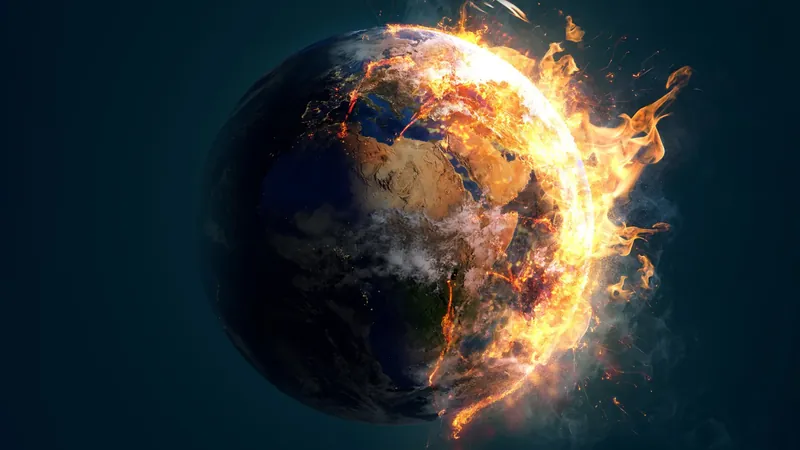
Unlocking the Secrets of Earth’s Greatest Extinction: How Rainforest Collapse Fueled Catastrophic Climate Change
2025-07-03
Author: Mei
The Great Dying: A Cataclysmic Event 252 Million Years Ago
Around 252 million years ago, Earth faced its most devastating extinction event, known as the Permian-Triassic Mass Extinction or the "Great Dying." This catastrophic period saw the extinction of massive marine species and plummeting numbers of terrestrial plants and animals.
The Role of Volcanic Activity
Traditionally, scientists linked this disaster to extreme global warming caused by volcanic eruptions in Siberia, known as the Siberian Traps. However, the enduring super-greenhouse conditions that lasted for approximately five million years after the extinction remained a mystery.
New Insights into Carbon Sequestration
A groundbreaking study led by the University of Leeds and the China University of Geosciences now sheds light on this enigmatic period. Researchers have gathered compelling evidence suggesting that the collapse of tropical forests and their sluggish recovery drastically hampered carbon sequestration—an essential process where carbon dioxide is absorbed from the atmosphere.
Reconstructing Ancient Ecosystems
Utilizing innovative fossil record analysis and insights into past climate conditions, the team meticulously reconstructed maps reflecting the shifts in plant productivity during the extinction event. Their findings, published on July 2 in Nature Communications, reveal that the significant loss of vegetation directly resulted in reduced carbon sequestration, contributing to the persistent high levels of atmospheric CO2.
Dr. Zhen Xu: Leading the Charge in Paleontological Research
Dr. Zhen Xu, the study's lead author from the University of Leeds, emphasized the unique nature of this historical warming event. "This event is distinct because it marks the only time in Earth's history where the tropical forest ecosystem collapsed, validating our initial theory," she stated, highlighting the importance of their findings.
Understanding Climate 'Tipping Points'
The researchers advocate that their results reinforce the notion of climate-carbon 'tipping points'—thresholds beyond which warming can escalate uncontrollably. With the most comprehensive geological record of the Permian-Triassic extinction located in China, this study effectively utilizes decades of fossil data gathered by generations of geologists.
A Call to Action for Modern Climate Concerns
Professor Benjamin Mills shared a crucial warning: the state of today’s tropical forests may determine the future of our climate. "If rapid warming leads to a similar collapse, we could see an acceleration of warming even after halting CO2 emissions. The carbon cycle will be irrevocably altered, taking geological timeframes to recover," he cautioned.
Bridging Past and Future—A Responsibility for All
Professors Hongfu Yin and Jianxin Yu from the China University of Geosciences stressed the importance of combining traditional paleontological approaches with modern techniques. "It's our duty to ensure that our research extends beyond academia to protect all life on Earth. The narrative of Earth is still unfolding, and we each play a part in its next chapter," they asserted.
Research Support and Collaboration
This significant research is funded by UK Research and Innovation (UKRI) and the National Natural Science Foundation of China (NSFC), highlighting international collaboration to unravel the mysteries of our planet’s past and safeguard the future.

 Brasil (PT)
Brasil (PT)
 Canada (EN)
Canada (EN)
 Chile (ES)
Chile (ES)
 Česko (CS)
Česko (CS)
 대한민국 (KO)
대한민국 (KO)
 España (ES)
España (ES)
 France (FR)
France (FR)
 Hong Kong (EN)
Hong Kong (EN)
 Italia (IT)
Italia (IT)
 日本 (JA)
日本 (JA)
 Magyarország (HU)
Magyarország (HU)
 Norge (NO)
Norge (NO)
 Polska (PL)
Polska (PL)
 Schweiz (DE)
Schweiz (DE)
 Singapore (EN)
Singapore (EN)
 Sverige (SV)
Sverige (SV)
 Suomi (FI)
Suomi (FI)
 Türkiye (TR)
Türkiye (TR)
 الإمارات العربية المتحدة (AR)
الإمارات العربية المتحدة (AR)